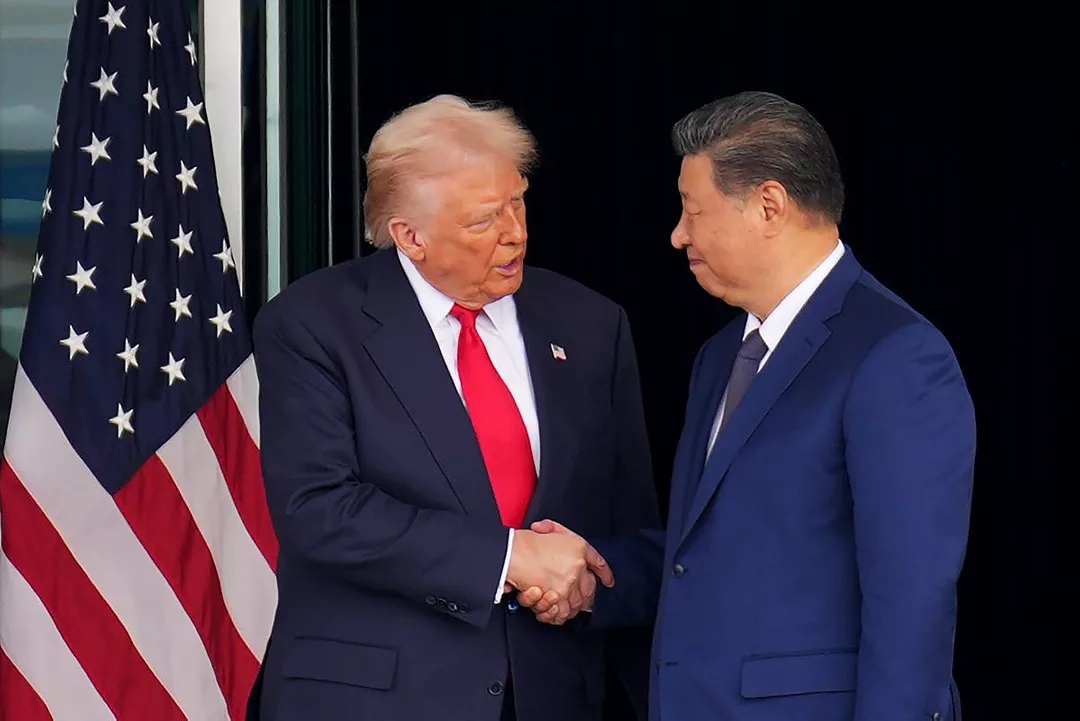World
Trump and Xi Forge Temporary Accord on Rare Earth Exports

U.S. President Donald Trump and Chinese President Xi Jinping reached a temporary agreement regarding rare earth exports during their recent meeting, a significant development in U.S.-China relations. The meeting, which marked the first face-to-face interaction since Trump returned to office in January, resulted in China delaying the implementation of new export controls for critical minerals for one year. This move aims to ease tensions and provide some relief to industries reliant on these essential resources.
Trump expressed optimism after the meeting, stating, “There’s no roadblock at all on rare earth,” while aboard Air Force One. He framed the agreement as a win not just for the U.S., but for the global economy. The pause on new export controls from China, which are vital for sectors including defense and technology, offers a temporary reprieve, although existing restrictions remain.
Despite the apparent gains, the arrangement has prompted skepticism among some U.S. officials and experts. The agreement requires the U.S. to postpone its own proposed expansion of export blacklists affecting numerous Chinese companies. U.S. Trade Representative Jamieson Greer acknowledged that the deal serves primarily as a continuation of prior commitments from China that have not been fulfilled. Greer noted that previous controls on rare earth magnets had improved flow but cautioned that more comprehensive negotiations are necessary for lasting change.
Concerns Over Bargaining Power
Critics suggest that the U.S. has conceded too much to China. Commentators like Derek Scissors from the American Enterprise Institute argue that American policy appears overly influenced by industries dependent on Chinese resources, such as automakers and agricultural producers. This raises concerns about the long-term implications of the U.S. accepting a link between its own export controls and China’s rare earth policies.
The recent negotiations illustrate China’s enhanced bargaining power in the current political climate. Chris McGuire, a former National Security Council official, highlighted the potential risks associated with the U.S. agreeing to roll back its controls instead of pushing back against China’s escalated restrictions. He described the precedent set by this agreement as “dangerous,” pointing out that the U.S. has historically not retreated in trade negotiations.
The one-year delay on new controls represents a temporary ceasefire rather than a resolution. While the U.S. maintains more targeted measures requiring frequent updates, the existing Chinese controls remain intact, benefiting Beijing as it retains significant leverage over critical supply chains.
Future Implications and Industry Impact
As industries reliant on rare earth imports brace for the ongoing complexities of U.S.-China trade relations, experts warn that little has changed in terms of operational practices. Companies seeking to import rare earth materials still face prolonged approval processes and stringent requirements from Chinese authorities.
The delay in new export controls may provide some relief for American firms looking to procure essential machinery for processing rare earths. However, industry insiders caution that without substantive changes in China’s licensing procedures, the situation may not improve significantly. Nazak Nikakhtar, a former official at the U.S. Department of Commerce, emphasized that ongoing restrictions could continue to hamper the ability of American industries to secure necessary materials.
Despite the optimistic narrative spun by Trump and his administration, the reality remains that substantial challenges persist. The Supreme Court is set to hear arguments regarding the legality of Trump’s tariffs, which could impact the administration’s ability to impose future trade barriers.
In conclusion, while the recent negotiations between the U.S. and China signal a temporary easing of tensions surrounding rare earth exports, the broader implications for global supply chains and U.S. industries remain uncertain. As both nations prepare for further discussions in 2026, the focus will likely shift back to addressing the fundamental issues that have long defined their economic relationship.
-

 World2 weeks ago
World2 weeks agoGlobal Air Forces Ranked by Annual Defense Budgets in 2025
-

 World2 weeks ago
World2 weeks agoMass Production of F-35 Fighter Jet Drives Down Costs
-

 Top Stories2 weeks ago
Top Stories2 weeks agoNew ‘Star Trek: Voyager’ Game Demo Released, Players Test Limits
-

 Top Stories2 weeks ago
Top Stories2 weeks agoDirecTV to Launch AI-Driven Ads with User Likenesses in 2026
-

 Science2 weeks ago
Science2 weeks agoTime Crystals Revolutionize Quantum Computing Potential
-

 World2 weeks ago
World2 weeks agoElectrification Challenges Demand Advanced Multiphysics Modeling
-

 Entertainment2 weeks ago
Entertainment2 weeks agoFreeport Art Gallery Transforms Waste into Creative Masterpieces
-

 Lifestyle2 weeks ago
Lifestyle2 weeks agoDiscover Reese Witherspoon’s Chic Dining Room Style for Under $25
-

 Health2 weeks ago
Health2 weeks agoGavin Newsom Critiques Trump’s Health and National Guard Plans
-

 Lifestyle2 weeks ago
Lifestyle2 weeks agoLia Thomas Honored with ‘Voice of Inspiration’ Award at Dodgers Event
-

 Entertainment2 weeks ago
Entertainment2 weeks agoFast & Furious Coaster Hits the Track at Universal Studios
-

 Health2 weeks ago
Health2 weeks agoResearchers Uncover New Insights into Cancer Mortality Causes









